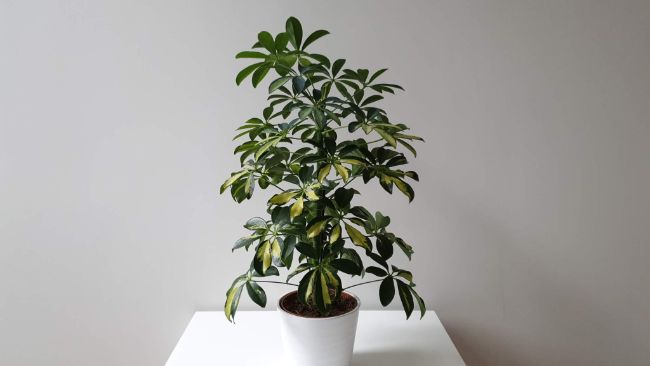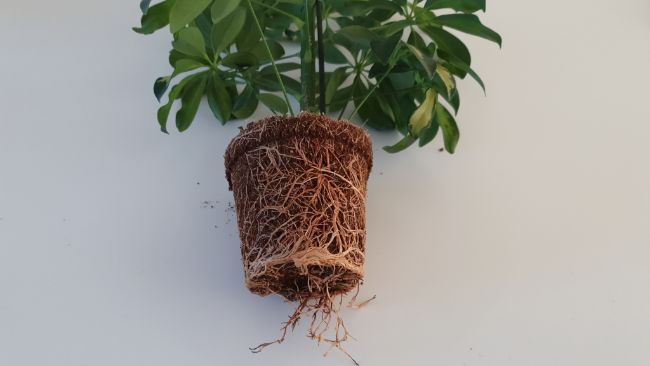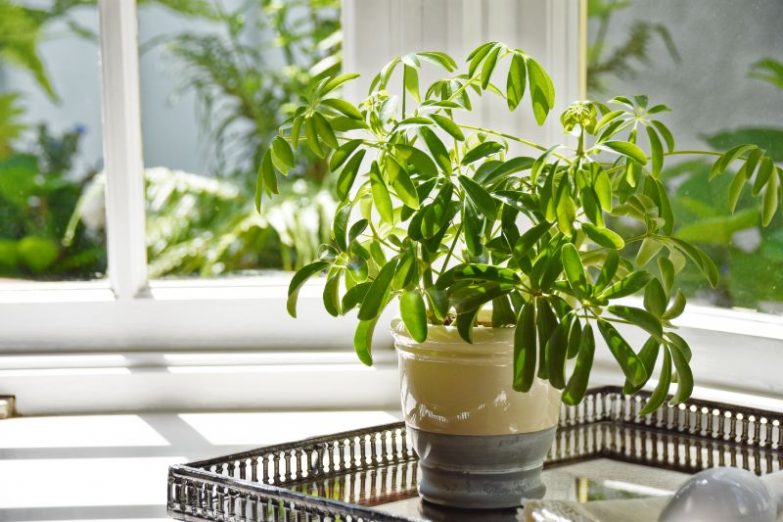If you’ve just found your Umbrella Plant drooping, you’ll be keen to fix it as soon as possible. However, before you start, it’s essential to find out what’s causing the problem, so you can successfully help your plant thrive again.
The most common cause of an Umbrella Plant drooping is overwatering, resulting in root rot. Signs of this include yellow lower leaves, poorly draining soil and an offensive smell from the soil. Other causes of drooping include cold stress, transplant shock, underwatering, or overfertilizing.
6 Reasons Why Your Umbrella Plant Is Drooping
I’m going to cover each of the causes of a drooping Umbrella Plant (Schefflera arboricola) in turn, explaining the symptoms to look for and how to fix and prevent each issue. Let’s get started.
Overwatering
By far the most common cause of an Umbrella Plant drooping is overwatering. When I say overwatering, what I really mean is any conditions that cause the soil to remain wet or poorly aerated for a long time.
This will cause the roots to suffer, become diseased, and die. Without functioning roots, your plant will be unable to absorb the water and nutrients it needs to survive and will start to droop dramatically.
Here are the symptoms to look for that might indicate that overwatering is the cause of your Umbrella Plant drooping;
- Your plant is wilting but the soil feels wet.
- The lower leaves may be starting to turn yellow. Although other things can cause yellow leaves, it is a very common sign of overwatering.
- You may see brown tips on the leaves, particularly younger leaves. Unlike other causes of brown leaf tips, the leaves will be limp and they may show yellow mottling.
- There may be an offensive smell coming from the soil. This is a sign of root rot.
- You may also see leaves or branches dropping. I’ve written a separate article on leaf drop in Schefflera plants.
If this sounds like what is happening with your plant, let’s now think about what factors could have caused the problem. It’s not always just as simple as watering too often.
- Your plant is in low light conditions. Plants in low light grow more slowly and use less water, making overwatering problems much more likely.
- You have been watering on a schedule. Make sure that the top few inches of soil feel dry before watering your Umbrella plant, rather than watering on a set schedule.
- The plant pot has few or no drainage holes. Drainage holes are essential to let the excess water drain out of the soil and away from the roots after watering, to reduce the risk of root rot.
- You sometimes forget to empty the drip tray or outer decorative pot after watering. Leaving the bottom of the pot sitting in water will submerge the roots, preventing root aeration. It won’t take long for root rot to set in.
- The soil drains poorly. Poorly draining soil dramatically increases the risk of root rot, and even if you provide good care, can result in an unhappy plant that fails to thrive. Make sure to use a well-draining potting mix, and ideally add some coarse sand, perlite, or gravel to the mix to improve drainage. Learn more about making or buying a good potting mix here.
- Your plant is in a pot that is too large. If you have a small plant in a large pot, the soil will take a very long time to dry out after watering. Match plant and pot size closely so your plant won’t be left sitting for weeks in a mass of soggy soil.
- You forget to reduce watering in winter when water use is lower due to slower growth and reduced evaporation.
Once root rot sets in, its only a matter of time before your Umbrella Plant starts drooping.
What To Do If Your Umbrella Plant Is Drooping Due To Overwatering
If your plant is drooping due to overwatering, you need to take immediate action to save your plant.
- Slide your Umbrella Plant out of the pot and remove excess soil so that you can inspect the roots. Rotten roots will be black/brown, feel mushy, and will smell bad.
- Using sharp, sterile pruning shears, remove any unhealthy roots. If you have to remove more than half of the roots, consider pruning the foliage back so that the remaining healthy roots can support the plant’s needs.
- I normally wash the remaining soil from the healthy roots, in case any of the pathogens that caused the root rot remains in the potting mix.
- Choose a new, clean pot that is only just big enough for the plant. Make sure it has plenty of drainage holes.
- Use fresh potting mix – 2/3 commercial potting mix and 1/3 coarse sand or perlite is a good option.
- Gently repot your plant, taking care not to compact the new soil excessively.
- Water your Umbrella Plant lightly and place in bright, indirect light.
You will need to provide great care conditions for the next while to help your Umbrella Plant recover. It will take a few months to grow healthy new roots, and this will then be followed by new leaves.

Cold Stress
Shefflera arboricola is best grown in temperatures of 65-90°F (18-32°C), but can tolerate temperatures of as low as 35°F (2°C). Even a short period of time below this can cause significant damage to your plant, and it will likely droop and die back.
Obviously, this is unlikely to be an issue indoors, but your plant could be exposed to low temperatures on the journey from the grower to the store, or on the way to your home.
In addition, if you grow your Umbrella Tree outside, or put your plant outside over the summer and forget to bring it inside as the cool nights of winter approach, it could be exposed to low temperatures.
Interestingly, even if your Umbrella Tree dies or droops badly due to cold stress, the roots are much more hardy, and the plant can recover or grow again even if the foliage dies back completely.
Transplant Shock
If you repot an Umbrella Plant that is already sickly or stressed, it can make the situation worse. Sometimes the roots will cease functioning temporarily and this will result in your Umbrella Plant drooping really badly.
Many plant won’t survive transplant, shock, but as Umbrella Plants are a bit more resilient than many houseplants, you can usually nurse your plant back to health with good care.
It is generally best to avoid repotting a stressed plant unless failure to repot is likely to result in the death of the plant anyway. If you do repot, try not to disturb the roots unless necessary, and make sure to provide moderate, consistent conditions after repotting.
Underwatering
This might seem obvious, but underwatering is also a very common cause of an Umbrella Tree drooping. If you struggle to remember to water your Umbrella Tree, you may see it wilting sadly, and discover the soil is as dry as dust. The solution is simple, but prevention can be more tricky as we go about our busy lives.
- Try to pick a time of the day or the week to check your houseplants. Once it becomes a habit it will be much harder to forget to give your plants a quick check.
- Place your plants somewhere you will see them on a regular basis. You are more likely to remember to check and water them if you can see them.
- Consider using a self-watering pot, so they can go a lot longer without needing attention.
In addition to remembering to water your plants, make sure you are giving your Umbrella Plant a good drink when you do water it. Sometimes when you water a plant that has dry soil, the water will run through the pot quickly without really soaking the soil.
Add a little water at a time to give the soil plenty of time to absorb the water. Alternatively, place the pot in a sink filled with a few inches of water and let the soil soak up water from the bottom.
Another thing to bear in mind is that rootbound plants are much more likely to show signs of underwatering. As the pot will be full of more roots than soil, the plant will use any available water very quickly. It can also be hard for water to get into the tightly coiled rootball.

Pests
A range of pests can attack your plant, and a bad infestation can result in your Umbrella Plant drooping. Mealybugs, thrips, scale, and spider mites are the most common offenders. All these bugs will feed on your plant, particularly on the juices within the stems and leaves.
This will cause significant water loss and stress, which will result in your Umbrella Plant drooping. It’s important to check your plant on a regular basis for any signs of pests and deal with them promptly. A few bugs will rarely cause a major problem, but a bad infestation could kill your plant.
If you discover pests on your Umbrella Plant, follow these steps;
- Separate the affected plant from any other houseplants, to prevent the bugs from spreading.
- Manually remove as many of the pests as possible. You can use a damp cloth, or soak the plant gently with a hose or showerhead to dislodge as many as possible.
- Spray your plant with either neem oil, horticultural soap, or isopropyl alcohol. Test a small area of the plant to ensure your plant can tolerate this. None of these treatments use harmful chemicals and are safe to use in a home with pets or children.
- Re-treat your Umbrella Plant on a weekly basis until you are confident that there are no more pests. At this point, you can move your plant back to its normal spot.
- Read my guide to identifying, treating, and preventing common houseplant pests to learn more.
Overfertilizing
When it comes to fertilizing plants, you’re much more likely to cause a problem by adding too much, rather than too little. As with so many things, whilst a little can be great for the health of your plant, too much can be toxic.
The first signs of overfertilizing are usually brown patches, edges, or tips on the leaves. In addition, you may see fertilizer salt deposits accumulating in the soil.
Applying too much over time, or a super strength dose on one occasion can damage the roots and prevent them from working. This leads to the plant being unable to absord the essential water and nutrients that it needs to survive and thrive. All this will result in your Umbrella Plant drooping.
If you think you may have been feeding your Umbrella Plant too much or too often, you have two options to fix your plant.
Option 1 – Flush the soil with copious quantities of water to help rinse excess fertilizer salts out of the soil. It’s a good practice to routinely flush the soil of most houseplants every few months to prevent the build-up of fertilizer salts over time.
Option 2 – If your plant is really struggling, you can repot it in fresh soil. This is a high-risk strategy, as it may cause transplant shock. However, if disaster has struck, it may be the best choice to give your plant a shot at survival.
Last Word
Hopefully, this article has helped you stop your Umbrella Plant drooping, as well as get a better idea of the main factors that can cause problems in the future.
If you’d like to learn how to keep your houseplants thriving year after year check out my book, Houseplants Made Easy. It covers everything you need to know to grow beautiful, thriving houseplants and prevent and fix every common houseplant problem.

